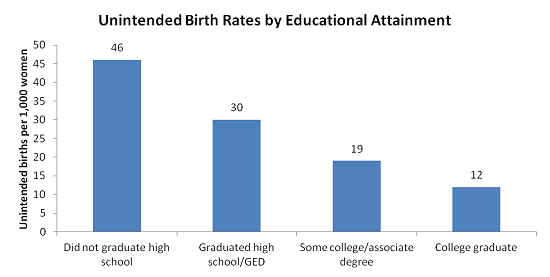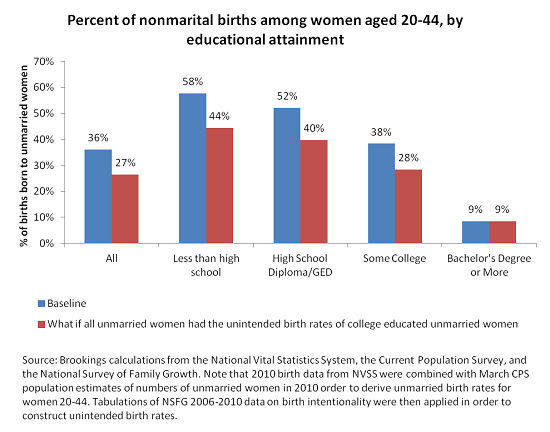In yesterday’s post, we showed the massive gains for women after the Pill became available. Despite this progress, we have very high unintended pregnancy rates that continue to rise. Between 1994 and 2006, rates of unintended pregnancy jumped by 16 percent from 45 to 52 unintended pregnancies per 1,000 women. Today, a little over half of all pregnancies and 38 percent of all births in the United States are unintended.
Why worry about unintended pregnancy?
- It’s bad for women: Women who experience unintended pregnancy are more likely to have mental health problems and to delay the initiation of prenatal care than women who intended to become pregnant.
- It’s bad for kids: Because most unplanned pregnancies occur to unmarried women, the children of unintended conceptions often grow up in single parent households. Compared to their intended counterparts, children of unintended pregnancies tend to suffer from poorer physical and mental health, and are more likely to engage in delinquent behavior during adolescence.
- It costs taxpayers a lot of money: Unintended pregnancies are concentrated among low-income women, so more unplanned pregnancies lead to more taxpayer dollars spent on public programs such as Medicaid. One recent study, for instance, found that existing publicly funded contraceptive services saved federal and state governments $7.6 billion per year by averting an estimated 2.2 million unwanted pregnancies.
Unintended Pregnancy Highest Among Less-Educated and Unmarried Women
Unmarried women account for 70 percent of all unintended pregnancies and 72 percent of all unwanted births, while unintended birth rates are nearly four times higher for high school drop outs than for college graduates:

What if fewer pregnancies were unintended?
We investigated the potential impact of reducing unintended pregnancy for less educated women to the same rates as college graduates. Helping these women have the same level of family planning control would reduce the overall share of births occurring to unmarried women from 36 percent to 27 percent.

These reductions are big, but not unattainable. In the short run, reducing unintended pregnancy will require significant changes in contraceptive behavior. For instance, the Choice Project – a program that provided no-cost contraception to nearly 10,000 women in the St. Louis region (many of whom were unmarried and from low socio-economic backgrounds) – shows that getting women onto highly effective, low-maintenance forms of contraception (e.g., IUDs or implants) can massively reduce the incidence of unintended pregnancy. In the longer term, however, radical reductions in unintended childbearing will require improving the educational attainment and economic prospects of the most disadvantaged.

Commentary
Reducing Unplanned Pregnancy
November 1, 2013